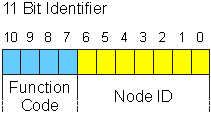Identifier Allocation
Default identifier
CANopen provides default identifiers for the most important communication objects, and these are derived from the 7-bit node address (the node ID) and a 4-bit function code in accordance with the following scheme:

For broadcast objects, the node ID is set to "0". This gives rise to the following default identifiers:
Broadcast objects
Object | Function | Function code | resulting COB ID hex / dec | Object for comm. parameter / mapping |
|---|---|---|---|---|
NMT | Boot up | 0 | 0x00 / 0 | - / - |
SYNC | Synch. | 1 | 0x80 / 128 | 0x1005 + 0x1006 / - |
Peer-to-peer objects
Object | Function | Function code | resulting COB ID hex / dec | Object for comm. parameter / mapping |
|---|---|---|---|---|
Emergency | Status / error | 1 | 0x81 - 0xFF/ 129 - 255 | - / - |
PDO1 (tx) | dig. inputs | 11 | 0x181 - 0x1FF / 385 - 511 | 0x1800 / 0x1A00 |
PDO1 (rx) | digital outputs | 100 | 0x201 - 0x27F/ 513-639 | 0x1400 / 0x1600 |
PDO2 (tx) | analog inputs | 101 | 0x281 - 0x2FF/ 641-767 | 0x1801 / 0x1A01 |
PDO2 (rx) | Analog outputs | 110 | 0x301 - 0x37F/ 769-895 | 0x1401 / 0x1601 |
SDO (tx) | Parameter | 1011 | 0x581 - 0x5FF/ 1409-1535 | - / - |
SDO (rx) | Parameter | 1100 | 0x601 - 0x67F/ 1537-1663 | - / - |
Guarding | Life/node guarding | 1110 | 0x701 - 0x77F/ 1793-1919 | (0x100C, 0x100D, 0x100E) |
 | Default identifier Up until version 3 of the CANopen specification, default identifiers were assigned to 2 PDOs at a time. The Beckhoff Bus Couplers correspond to this issue of the specification. After version 4, default identifiers are provided for up to 4 PDOs. |
Manufacture-Specific Default Identifiers for Additional PDOs
Default Identifiers for Additional PDOs
Identifiers are not assigned to the additional PDOs that are filled by the Beckhoff Bus Couplers in accordance with the standard scheme. The user must enter an identifier for these PDOs in the object directory. It is easier to activate the occupied PDOs by means of object 0x5500.
This entry in the object directory extends the allocation of default identifiers up to 11 PDOs. This creates the following identifiers:
Object | Function code | Resulting COB ID (hex) | Resulting COB ID (dec) |
|---|---|---|---|
PDO3 (tx) | 111 | 0x381 - 0x3BF | 897 - 959 |
PDO3 (rx) | 1000 | 0x401 - 0x43F | 1025 - 1087 |
PDO4 (tx) | 1001 | 0x481 - 0x4BF | 1153 - 1215 |
PDO4 (rx) | 1010 | 0x501 - 0x53F | 1281- 1343 |
PDO5 (tx) | 1101 | 0x681 - 0x6BF | 1665 - 1727 |
PDO5 (rx) | 1111 | 0x781 - 0x7BF | 1921- 1983 |
PDO6 (tx) | 111 | 0x1C1 - 0x1FF | 449 - 511 |
PDO6 (rx) | 1001 | 0x241 - 0x27F | 577 - 639 |
PDO7 (tx) | 1011 | 0x2C1 - 0x2FF | 705 - 767 |
PDO7 (rx) | 1101 | 0x341 - 0x37F | 833 - 895 |
PDO8 (tx) | 1111 | 0x3C1- 0x3FF | 961 - 1023 |
PDO8 (rx) | 10001 | 0x441 - 0x47F | 1089 - 1151 |
PDO9 (tx) | 10011 | 0x4C1 - 0x4FF | 1217 - 1279 |
PDO9 (rx) | 10101 | 0x541 - 0x57F | 1345 - 1407 |
PDO10 (tx) | 10111 | 0x5C1 - 0x5FF | 1473 - 1535 |
PDO10 (rx) | 11001 | 0x641 - 0x67F | 1601- 1663 |
PDO11 (tx) | 11011 | 0x6C1 - 0x6FF | 1729 - 1791 |
PDO11 (rx) | 11101 | 0x741 - 0x77F | 1857 - 1919 |
 | Ensure that index 0x5500 is not used if bus couplers with more than 5 PDOs are present in networks with node numbers >64, otherwise identification overlaps can occur. |